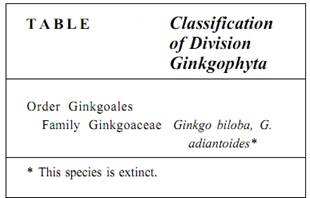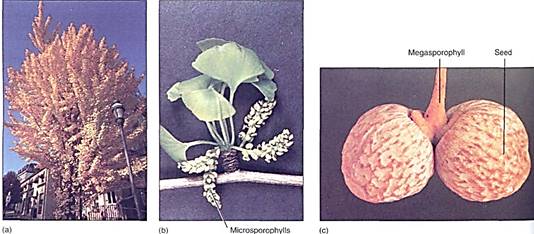


 النبات
النبات
 الحيوان
الحيوان
 الأحياء المجهرية
الأحياء المجهرية
 علم الأمراض
علم الأمراض
 التقانة الإحيائية
التقانة الإحيائية
 التقنية الحيوية المكروبية
التقنية الحيوية المكروبية
 التقنية الحياتية النانوية
التقنية الحياتية النانوية
 علم الأجنة
علم الأجنة
 الأحياء الجزيئي
الأحياء الجزيئي
 علم وظائف الأعضاء
علم وظائف الأعضاء
 الغدد
الغدد
 المضادات الحيوية
المضادات الحيوية|
Read More
Date: 24-11-2016
Date: 27-11-2016
Date: 24-11-2016
|
Division Ginkgophyta: Maidenhair Tree
This division contains a single living species, Ginkgo biloba (Fig. ; Table ). It may seem unusual to erect an entire division for a single species, but G. biloba (the "maidenhair tree") is itself unusual. It looks very much like a large dicot tree with a stout trunk and many branches, but its wood, like that of conifers, lacks axial parenchyma. It has "broad leaves," but they have dichotomously branched veins like seed ferns, not reticulate venation like dicots. Ginkgos have both short shoots, which bear most of the leaves, and long shoots. Reproduction in Ginkgo is dioecious and gymnospermous, but cones are not produced. Instead, ovules occur in pairs at the ends of a short stalk and are completely unprotected at maturity (Fig. c). Pollen is produced in an organ that resembles a catkin, having a stalk and several sporangiophores that each have two microsporangia. Like ovules of pteridosperms and cycads, the ovules of Ginkgo are large (1.5 to 2.0 mm in diameter) and develop a three-layered seed coat.


FIGURE : (a) A tree of Ginkgo biloba, the only species of this division, could easily be mistaken for a dicot tree. This photo shows its current typical habitat: in cultivation in cities. There may be no natural populations left; it has survived because it has been cultivated as an ornamental. (Doug Wkhda/ Earth Scenes) (b) Although Ginkgo leaves are broad, they have dichotomous venation like leaves of cycads and seed ferns, not reticulate venation like dicots. Microsporophylls occur in small, cone-like clusters, mixed with foliage leaves on short shoots. (John D. Cunningham/Visuals Unlimited) (c) Ovules occur in pairs at the end of a stalk-like megasporophyll. The ovule itself, the integument, is exposed; no bract or ovuliferous scale protects it. Here, both ovules have developed into seeds. (Robert Dunne/Photo Researchers)
A Ginkgo tree itself is beautiful and is a popular ornamental because the leaves turn brilliant yellow in autumn, but the microsporangiate ("male") trees are preferred; when the megasporangiate ("female") trees produce seeds, the outer fleshy layer of the seed emits butyric acid, which has a putrid odor that is difficult to tolerate.
The exact ancestors of ginkgos are not known, but they must have been one of the seed ferns or a closely related group. Ginkgos became abundant during the Mesozoic Era, especially in the mid-Jurassic Period (about 170 million years ago). An abundance of diverse fossilized leaves has been found, but it is difficult to know how many species they represent, because living G. biloba trees produce diverse types of leaves depending on the growing conditions. At present, about eight form genera for leaves are recognized. Fossilized remains of leaves and wood can be found in almost all areas of the world, especially in high latitudes such as Alaska, Canada, and Siberia near the North Pole, and Patagonia, South Africa, and New Zealand near the South Pole. Ginkgos began to die out early in the Tertiary Period, but two species, G. biloba and G. adiantoides, persisted. The latter species became extinct during the Pliocene Epoch, about 10 to 12 million years ago.



|
|
|
|
دراسة: حفنة من الجوز يوميا تحميك من سرطان القولون
|
|
|
|
|
|
|
تنشيط أول مفاعل ملح منصهر يستعمل الثوريوم في العالم.. سباق "الأرنب والسلحفاة"
|
|
|
|
|
|
|
لتعزيز التواصل مع الزائرات الأجنبيات : العتبة العلويّة المقدّسة تُطلق دورة لتعليم اللغة الإنجليزية لخادمات القسم النسويّ
|
|
|